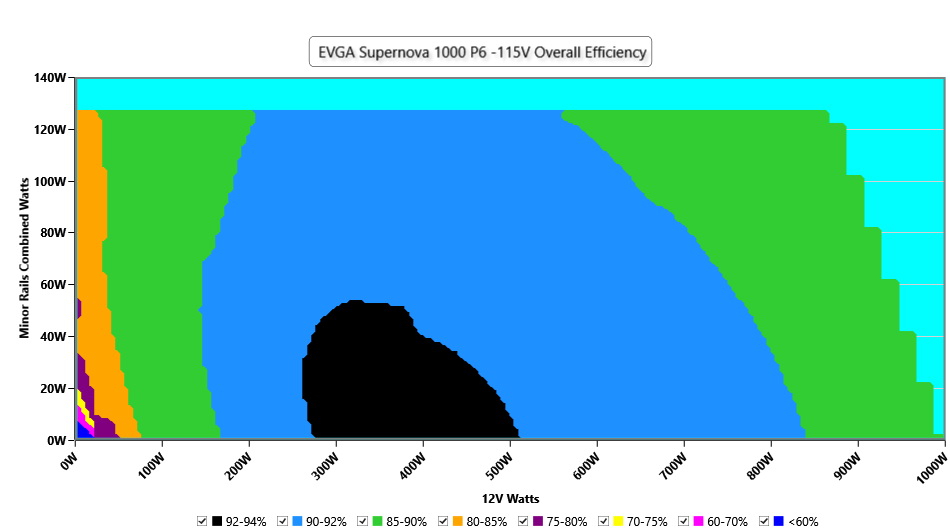Why you can trust Tom's Hardware
Protection Features
Check out our PSUs 101 article to learn more about PSU protection features.
| OCP (Cold @ 24°C) | 12V: 114.6A (137.58%), 12.146V 5V: 32.9A (131.6%), 5.011V 3.3V: 32.3A (129.2%), 3.279V 5VSB: 6.4A (213.33%), 4.953V |
| OCP (Hot @ 40°C) | 12V: 114.6A (137.58%), 12.151V 5V: 33.2A (132.8%), 5.005V 3.3V: 32.1A (128.4%), 3.278V 5VSB: 6.3A (210%), 4.948V |
| OPP (Cold @ 25°C) | 1391.89W (139.19%) |
| OPP (Hot @ 41°C) | 1392.46W (139.25%) |
| OTP | ✓ (150°C @ 12V Heat Sink) |
| SCP | 12V to Earth: ✓ 5V to Earth: ✓ 3.3V to Earth: ✓ 5VSB to Earth: ✓ -12V to Earth: ✓ |
| PWR_OK | Proper operation |
| NLO | ✓ |
| SIP | Surge: MOV Inrush: NTC Thermistor & Bypass relay |
EVGA claims that this PSU has two different OPP triggering points, but we only managed to activate one of them, the one that EVGA calls hardware OPP. OCP is set high on all rails, but this doesn't trouble load regulation and ripple suppression. OPP is also highly set, at almost 140%, and this can be a problem if some users push the PSU hard for prolonged periods under high temperatures. It would be ideal if OPP were set a bit lower. That said, the 1000 G6 has an even higher OCP at 12V and OPP. Our 1000 G6 unit shut down with close to 1450W load!
DC Power Sequencing
According to Intel’s most recent Power Supply Design Guide (revision 1.4), the +12V and 5V outputs must be equal to or greater than the 3.3V rail at all times. Unfortunately, Intel doesn't mention why it is so important to always keep the 3.3V rail's voltage lower than the levels of the other two outputs.



No problems here since the 3.3V rail is always lower than the other two.
Cross Load Tests
To generate the following charts, we set our loaders to auto mode through custom-made software before trying more than 25,000 possible load combinations with the +12V, 5V, and 3.3V rails. The deviations in each of the charts below are calculated by taking the nominal values of the rails (12V, 5V, and 3.3V) as point zero. The ambient temperature during testing was between 30 to 32 degrees Celsius (86 to 89.6 degrees Fahrenheit).
Load Regulation Charts




Efficiency Graph
Ripple Graphs
The lower the power supply's ripple, the more stable the system will be and less stress will also be applied to its components.




Infrared Images
We apply a half-load for 10 minutes with the PSU's top cover and cooling fan removed before taking photos with a modified Fluke Ti480 PRO camera able to deliver an IR resolution of 640x480 (307,200 pixels).
Get Tom's Hardware's best news and in-depth reviews, straight to your inbox.




The temperatures inside the PSU, with a 500W load for ten minutes without active cooling, are low. The hottest parts are the 12V heat sinks and the area around the standby controller.
MORE: Best Power Supplies
MORE: How We Test Power Supplies
MORE: All Power Supply Content
Current page: Protection Features, DC Power Sequencing, Cross-Load Tests and Infrared Images
Prev Page Load Regulation, Hold-Up Time, Inrush and Leakage Current, Efficiency and Noise Next Page Transient Response Tests, Timing Tests, Ripple Measurements and EMC Pre-Compliance Testing
Aris Mpitziopoulos is a contributing editor at Tom's Hardware, covering PSUs.
